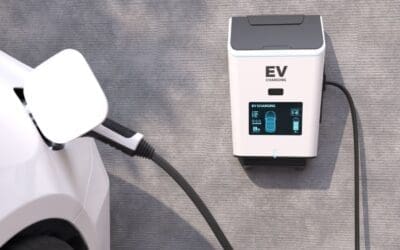In a world driven by the urgency of sustainability, electric vehicles (EVs) have emerged as pivotal players in the transition towards eco-friendly transportation. While the spotlight often shines on EVs themselves, the significance of their supporting infrastructure—the electric vehicle charging stations—should not be underestimated.
Electric vehicle charging stations have taken center stage as catalysts for change. Beyond the mere convenience they offer, these stations are essential components of a more sustainable future.
⦁ Rising Demand for Electric Vehicles (EVs):
As electric vehicles (EVs) gain traction, they’re guiding us towards a more environmentally friendly future. This change in direction highlights the need for a strong charging network that can outmatch the convenience of traditional gas-powered cars. The key to this transition is having dependable and efficient charging infrastructure.
⦁ Energy Sources for Charging Stations:
Electric vehicle charging stations source power diversely: solar, wind, hydro, and grid electricity. This choice carries major sustainability implications.
Renewables help by using clean sources like solar, wind, and hydro. In contrast, regional grid electricity may rely on non-renewables. Opting for renewables boosts overall network sustainability, fostering harmony with the environment.
⦁ Emission Reduction Potential:
Electric vehicles (EVs) and charging stations champion the battle against greenhouse gas emissions, outshining their gasoline counterparts. Case in point: EVs produce zero tailpipe emissions, slicing down carbon output.
A study by the Union of Concerned Scientists shows that, on average, EVs in the U.S. emit half the greenhouse gasses of comparable gasoline vehicles. Charging stations, when fueled by renewables, amplify this feat. For instance, the European Environment Agency finds that EVs charged by low-carbon electricity emit nearly 50% less CO2 over their lifespan. It’s a potent duo rewriting the eco-friendly transportation narrative.
⦁ Life Cycle Analysis:
Unveiling charging stations’ complete environmental journey, life cycle analysis examines their impact from inception to retirement. This encompassing perspective delves into manufacturing’s resource use, installation’s energy demands, operational emissions, and decommissioning waste. By comprehending these stages, life cycle assessments unveil the authentic environmental footprint.
Insights gleaned from this analysis steer sustainable choices, influencing materials, designs, and disposal methods. This approach guides us toward eco-friendly charging networks, forging a link between technology and environmental responsibility. With each phase accounted for, we’re charting a course toward greener infrastructure, harmonizing progress with the preservation of our planet.
⦁ Charging Infrastructure Placement:
Strategic charging station placement is pivotal in shaping an electrified future. Urban stations offer convenience for city dwellers, normalizing EVs and easing range anxiety. In rural locales, they diminish range-related concerns, widening EV adoption. Well-situated stations ensure EV accessibility, fostering a transition from fossil fuels.
A study in Nature Energy reveals that if charging stations are optimally positioned, EVs could replace 90% of conventional cars by 2030. This underscores the ripple effect of thoughtful infrastructure, revolutionizing both urban and rural landscapes while steering us closer to a sustainable horizon.
⦁ Technological Innovations:
Charging station technology leaps forward with innovations like fast charging and wireless options. Beyond enhancing user convenience, these advancements wield significant environmental influence.
Fast charging slashes waiting times, encouraging EV adoption. Meanwhile, wireless charging streamlines the process, minimizing physical wear and tear. This synergy of speed and simplicity results in efficient energy utilization.
A Department of Energy study notes that fast charging can decrease energy consumption by up to 60%. Such breakthroughs align user needs with sustainability goals, propelling us towards a future where charging is swift, seamless, and environmentally astute.
⦁ Grid Integration and Load Management:
Integrating charging stations into the grid poses complexities. Enter load management, a crucial concept. It fine-tunes energy distribution, averting grid strain during peak demand.
By regulating charging times, load management curbs overload, ensuring grid stability. It’s a linchpin of efficiency. A study by the International Council on Clean Transportation underscores its importance, predicting that with smart load management, grids can accommodate 30% more EVs without upgrades.
This harmonious balancing act fosters a robust charging network, reinforcing sustainable mobility by taming energy demands and harmonizing charging with the grid’s capacity.
Empowering a Sparkling Green Tomorrow
As we navigate the road to a more sustainable future, electric vehicles and their supporting charging stations emerge as champions of change. These unassuming charging hubs hold the power to redefine our transportation landscape by reducing emissions, enhancing convenience, and embracing innovation.
At Got Electric LLC, we’re committed to shaping this future. Serving Maryland, Virginia, and the DC Metro area, we’re your partners in building greener transportation options. Our expertise in EV charging infrastructure installation and smart load management ensures that you’re not just charging vehicles; you’re charging progress. Join us on this journey towards a cleaner, more efficient tomorrow. Give us a call at 301-515-8676 to be a part of the sustainable driving revolution.
With offices in Ijamsville, MD & Linville, VA, Got Electric offers residential and commercial electric work, including installation, safety inspections, repairs, lighting design, and troubleshooting.
Got Electric also specializes in solar Energy Projects. Our electricians are fully licensed by state and local jurisdiction, ensuring that your electrical projects will be installed to industry and code standards.
Energized by Auxilium Technology






